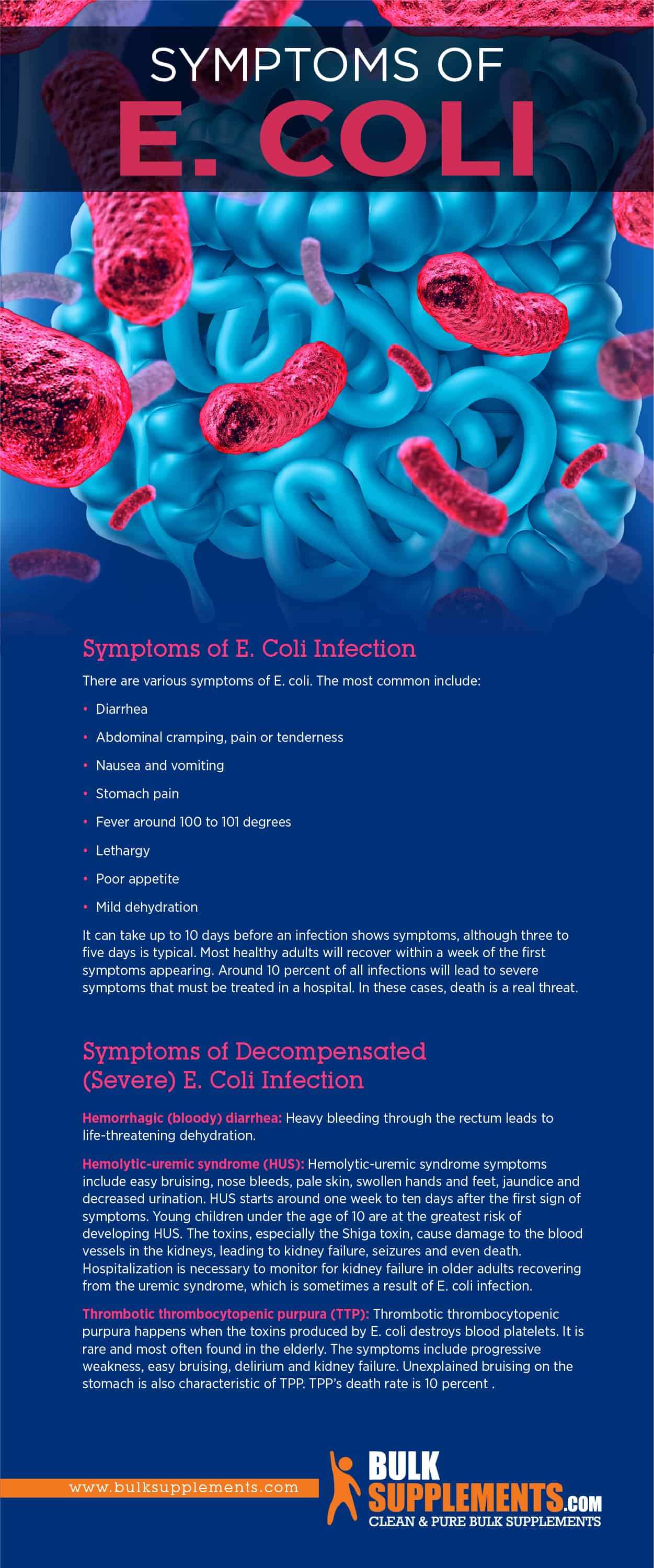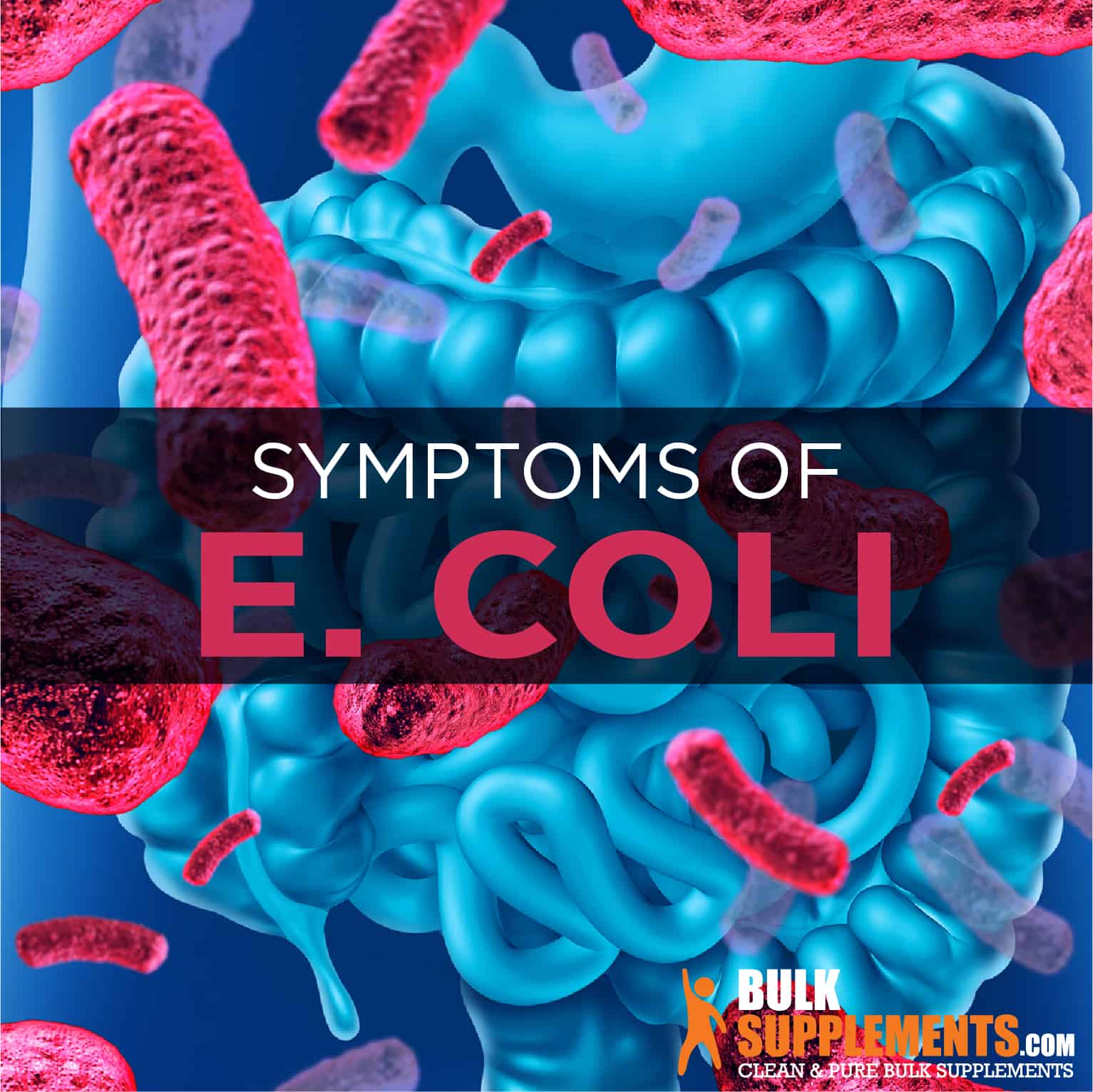What is E. Coli?
Escherichia coli, better known as E. coli, is a common bacterium that lives in the intestines. There are many varieties of the bacterium, but most of them are not harmful. However, some strains of E. coli are virulent and cause severe gastroenteritis, which entails cramping, severe diarrhea and vomiting (x). And things can get much worse. Further complications can arise, including hemorrhagic colitis (bloody diarrhea) and hemolytic uremic syndrome (HES), which can cause kidney failure and death (x).
Varieties
The most dangerous varieties of disease-causing E. coli are Shiga-toxin producing E. coli (STEC), Enterohemorrhagic E. coli (EHEC) that also excretes Shiga-toxin and Enterotoxigenic E. coli (ETEC) (x, x). When you hear about an outbreak of severe illness or fatalities from E. coli on the news, most of the time STEC, EHEC or ETEC are the culprits (x, x).
These types produce poisons that kill cells in the intestines and bowels, causing diarrhea, vomiting, painful cramps and, in some cases, blood poisoning. Even worse, STEC variations do severe damage to tiny blood vessels like those found in the kidneys. Infections in babies, toddlers and the elderly can become life-threatening in a matter of hours.
E. coli septicemia follows when E. coli enters the bloodstream (x). In this case, it is essential to seek medical treatment immediately. E. coli pneumonia is rare and results from infection in the lungs (x).
Extent of Effects
STEC infections affect around 100,000 Americans a year, leading to 3,000 hospitalizations and 90 deaths. Diagnosis of STEC infection requires testing a stool sample (x).
Most people who have an infection but were healthy before they were infected recover without lasting harm. E. coli endangers young children, senior citizens and those with pronounced health problems to the greatest degree.
Symptoms of E. Coli Infection
There are various symptoms of E. coli. The most common include:
- Diarrhea
- Abdominal cramping, pain or tenderness
- Nausea and vomiting
- Stomach pain
- Fever around 100 to 101 degrees
- Lethargy
- Poor appetite
- Mild dehydration
It can take up to 10 days before an infection shows symptoms, although three to five days is typical. Most healthy adults will recover within a week of the first symptoms appearing. Around 10 percent of all infections will lead to severe symptoms that must be treated in a hospital. In these cases, death is a real threat (x).
Symptoms of Decompensated (Severe) E. Coli Infection
Hemorrhagic (bloody) diarrhea: Heavy bleeding through the rectum leads to life-threatening dehydration (x).
Hemolytic-uremic syndrome (HUS): Hemolytic-uremic syndrome symptoms include easy bruising, nose bleeds, pale skin, swollen hands and feet, jaundice and decreased urination. HUS starts around one week to ten days after the first sign of symptoms. Young children under the age of 10 are at the greatest risk of developing HUS. The toxins, especially the Shiga toxin, cause damage to the blood vessels in the kidneys, leading to kidney failure, seizures and even death (x). Hospitalization is necessary to monitor for kidney failure in older adults recovering from the uremic syndrome, which is sometimes a result of E. coli infection.
Thrombotic thrombocytopenic purpura (TTP): Thrombotic thrombocytopenic purpura happens when the toxins produced by E. coli destroys blood platelets. It is rare and most often found in the elderly. The symptoms include progressive weakness, easy bruising, delirium and kidney failure. Unexplained bruising on the stomach is also characteristic of TPP. TPP’s death rate is 10 percent (x).

How Does E. Coli Spread?
E. coli passes through the feces of humans and animals. If feces contaminate drinking water or foods of any sort, whether meats, fruits or vegetables and then consumed, E. coli infections will occur (x). The bacteria can be contagious depending on the strain. Strains that pass through the fecal or oral route can be transmitted from person to person directly, and contaminated food or water easily transmits microscopic amounts of E. coli, leading to severe illness.
Contaminated Food and Water
E. coli is most often transmitted by consuming contaminated food, with 69 percent of all infections occurring through the food route (x). Common foods that are easily infected include:
- Ground beef: When cattle are processed, the bacteria from their intestines can be transferred on the meat.
- Unpasteurized milk: E. coli bacteria are often found on cow udders and can get into raw milk.
- Fresh produce: Cattle farms or pastures contaminate water runoff which can wash into vegetable fields. Produce that’s eaten before it’s thoroughly washed can easily transmit the bacteria.
- Contaminated water: Animal and human feces may leach into water sources, like groundwater and water used for irrigation. Infections from drinking contaminated water make up 18 percent of all cases.
Person-to-Person Contact
E. coli bacteria passes from person to person easily when people don’t wash their hands regularly. A cluster outbreak can happen when one person is infected, becomes sick and spreads the bacterium inadvertently. E. coli is shed through the bowels and can become aerosolized; that is, flushing a toilet is enough to send microscopic amounts of it into the air, where it then infects others. Nonetheless, person-to-person contact amounts for only 6 percent of all infections (x, x).
Strains that cause urinary tract infections are not contagious. Casual, brief contact, like shaking hands, rarely transmits E. coli person to person. Strains that provoke diarrhea (enteropathogenic E. coli) are contagious (x).
Where is E. Coli Found?
E. coli can be found everywhere. It’s a common free-living organism in the soil and found in the feces of all warm-blooded animals. It can inhabit free-standing water. Swimming pools that are underchlorinated or un-chlorinated can transmit E. coli, as can ponds and lakes contaminated with runoff water from fields or pastures (x).
Questions
At what temperature does E. coli die? Most strains die at 140 to 160 degrees F, but some strains can survive much higher temperatures (x). It can be killed by cooking at the proper temperatures. Do note, though, that washing vegetables and fruit before eating them is a good practice. However, washing vegetables isn’t enough to remove every trace of E. coli if it’s present.
Why does spinach cause diarrhea? The texture and wrinkled nature of spinach leaves make it very hard for washing to remove all E. coli bacteria that might be present. Only through cooking at 150 to 160 degrees F will remove all of the bacteria.
How does E. coli get in urine? Well, it is a common cause of urinary tract infections in women. The proximity of the female urethral opening to the anus means a greater chance of bacteria transferring into the urethra and then to the bladder (x).
Can E. coli be sexually transmitted? It’s possible in the case of anal intercourse. The rectum is heavily populated with the bacteria (x).
Can Romaine lettuce cause diarrhea? Yes, any food contaminated with the bacteria will cause diarrhea. In fact, diarrhea after eating spinach may be caused by E. coli, due to the difficulty of sanitizing it without high-temperature cooking (x).
Can cheese cause diarrhea? Unpasteurized cheeses, and undercooked ground beef and burgers are prime routes of E. coli infection. Contaminated food causes about 68 percent of all E. coli infections every year, while contaminated water leads to eighteen percent of E. coli infections (x).
Supplements for E. Coli Infection
Supplements cannot prevent E. coli, but they contribute to the health of the digestive tract. A healthy diet filled with the right supplements helps speed recovery from an infection.
Insulin Powder
Inulin (FOS) powder comes from the root of the chicory plant and is a potent prebiotic. Prebiotics are nondigestible types of food that support the health of intestinal microorganisms that keep our intestines healthy (x). Take 2,600 mg (1 tsp) of inulin (FOS) powder one to three times daily with food or a beverage, or as directed by a physician. However, to avoid stomach upset, begin with smaller doses.
L-Methionine Powder
L-methionine is one of the nine amino acids essential for human life (x). As a dietary supplement, take 500 mg (rounded 1/4 tsp) of L-methionine one to two times daily, or as directed by a physician.
L-Glutamine
The tissues of the intestines use L-glutamine as a source of energy. Try taking 500 mg (scant 1/4 tsp) to 1,000 mg (scant 1/2 tsp) three times daily, preferably on an empty stomach. Of course, be sure to check in with a doctor.
Ginger Extract
Ginger extract reduces nausea and vomiting and calms irritated tissues in the digestive tract (x). Take 1,000 mg once daily unless a doctor gives a different recommendation.
Fish Oil Softgels
Omega-3 fatty acids in fish oil softgels help boost the health of helpful bacteria in the gut (x). Take two capsules two or three times a day. Each fish oil softgel capsule contains 330 milligrams of eicosapentaenoic acid (EPA) and 230 milligrams of docosahexaenoic acid (DHA).
Pure Phytosterol
Phytosterol is a form of plant sterol, similar to cholesterol. Phytosterol reduces LDL (or bad cholesterol) (x). Taking 1,000 mg (rounded 1/2 tsp) of phytosterol once or twice daily before meals could make a difference.
Pure Calcium Pyruvate Powder
Calcium Pyruvate seems to increase metabolism and helps regenerate tissue (x). Take 2,000 mg (scant 1/2 tsp) once to three times per day, or as directed by a physician.
The Bottom Line
E. coli infection results in painful stomach cramps, vomiting and severe diarrhea and has the potential to become life-threating. Because of this, thoroughly wash and cook your meats and produce to help prevent an infection. While supplements cannot treat or prevent an infection, some of them can help build up your digestive health to better equip you if you get infected.


